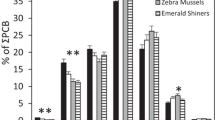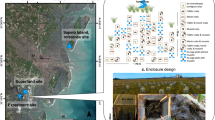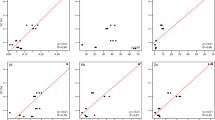Abstract
Shellfish and sediment invertebrates have been widely used to assess pollution trends over space and time in coastal environments around the world. However, few studies have compared the bioaccumulation potential of different test species over a range of sediment-contaminant concentrations and profiles. The bioavailability of sediment-related contaminants was evaluated using sediments collected from sites (n = 12) throughout the Salish Sea, British Columbia, Canada. Two benthic marine invertebrates—the Baltic clam Macoma balthica and the polychaete worm Neanthes arenaceodentata—were exposed for 28 days in a controlled environment to these field-collected coastal sediments. The congener-specific uptake of legacy polychlorinated biphenyls (PCBs) and emergent polybrominated diphenyl ethers (PBDEs) was determined using high-resolution gas chromatography/mass spectrometry in sediments and in invertebrates after the experimental exposure. The polychaete Neanthes accumulated lower concentrations of PCBs but higher concentrations of PBDEs. The present study indicates that differences in bioaccumulation between these two invertebrates shape the accumulation of PCB and PBDE congeners, reflect differences in feeding strategies, and reveal the physicochemical properties of the contaminants and sediment properties. Because biota–sediment accumulation factor values are often calculated for environmental monitoring or site-specific impact assessments, our results provide insight into potentially confounding factors and the need for caution when selecting indicator species for coastal marine pollution.







Similar content being viewed by others
References
Ahrens MJ, Hertz J, Lamoureux EM, Lopez GR, McElroy AE, Brownawell BJ (2001) The role of digestive surfactants in determining bioavailability of sediment-bound hydrophobic organic contaminants to 2 deposit-feeding polychaetes. Mar Ecol Prog Ser 212:145–157
Alava JJ, Ross PS, Lachmuth CL, Ford JKB, Hickie BE, Gobas FAPC (2012) Habitat-based PCB environmental quality criteria for the protection of endangered killer whales (Orcinus orca). Environ Sci Technol 46:12655–12663
ATSM International (2010) Standard guide for determination of the bioaccumulation of sediment-associated contaminants by benthic invertebrates. ATSM, Conshohocken
Booij K, Zegers BN, Boon JP (2002) Levels of some polybrominated diphenyl ether (PBDE) flame retardants along the Dutch coast as derived from their accumulation in SPMDs and blue mussels (Mytilus edulis). Chemosphere 46:683–688
Boon JP, Eijgenraam F, Everaarts JM, Duinker JC (1989) A structure-activity relationship (SAR) approach towards metabolism of PCBs in marine animals from different trophic levels. Mar Environ Res 27:159–176
Bosworth WS, Thibodeaux LJ (1990) Bioturbation: a facilitator of contaminant transport in bed sediment. Environ Prog 9:211–217
Braekevelt E, Tittlemier SA, Tomy GT (2003) Direct measurement of octanol–water partition coefficients of some environmentally relevant brominated diphenyl ether congeners. Chemosphere 51:563–567
Bridges TS, Farrar JD (1997) The influence of worm age, duration of exposure and endpoint selection on biassay sensitivity for Neanthes arenaceodentata. Environ Toxicol Chem 16:1650–1658
Burkhard LP, Cook PM, Lukasewycz MT (2005) Comparison of biota-sediment accumulation factors across ecosystems. Environ Sci Technol 39:5716–5721
Canadian Environmental Protection Act (2001) Disposal at sea regulations and regulations respecting applications for permits for disposal at sea. SOR/2001-275 and 276
Canadian Council of Ministers of the Environment (CCME) (2001) Canadian sediment quality guidelines for the protection of aquatic life: introduction. Updated. In: Canadian environmental quality guidelines, 1999, Canadian Council of Ministers of the Environment, Winnipeg
Cardoso JFMF, Witte JIJ, van der Veer HW (2006) Intra- and interspecies comparison of energy flow in bivalve species in Dutch coastal waters by means of the Dynamic Energy Budget (DEB) theory. J Sea Res 56:182–197
Chapman PM, Downie J, Maynard A, Taylor LA (1996) Coal and deodorizer residues in marine sediments—contaminants or pollutants? Environ Toxicol Chem 15:638–642
Dean HK (2008) The use of polychaetes (Annelida) as indicator species of marine pollution: a review. Rev Biol Trop 56:11–38
DeBruyn AMH, Meloche LM, Lowe CJ (2009) Patterns of bioaccumulation of polybrominated diphenyl ether and polychlorinated biphenyl congeners in marine mussels. Environ Sci Technol 43:3700–3704
Di Toro DM et al (1991) Technical basis for establishing sediment quality criteria for nonionic organic chemicals using equilibrium partitioning. Environ Toxicol Chem 10:1541–1583
Dillon TM, Moore DW, Gibson AB (1993) Development of a chronic sublethal bioassay for evaluating contaminated sediment with the marine polychaete worm Nereis (Neanthes) arenaceodentata. Environ Toxicol Chem 12:589–605
Dinn PM, Johannessen SC, Ross PS, Macdonald RW, Whiticar MJ, Lowe CJ et al (2012) PBDE and PCB accumumulation in benthos near marine wastewater outfalls: the role of sediment organic carbon. Environ Pollut 171:241–248
Foster GD, Baksi SM, Means JC (1987) Bioaccumulation of trace organic contaminants from sediment by baltic clams (Macoma balthica) and soft-shell clams (Mya arenaria). Environ Toxicol Chem 6:969–976
Goldberg ED et al (1978) The mussel watch. Environ Conserv 5:101–125
Grant PBC et al (2011) Environmental fractionation of PCBs and PBDEs during particle transport as recorded by sediments in coastal waters. Environ Toxicol Chem 30:1522–1532
Hartley GS, Graham-Bryce IJ (1990) Physical principles of pesticide behavior, vol 1. Academic Press, London
Hawker DW, Connell DW (1988) Octanol–water partition coefficients of polychlorinated biphenyl congeners. Environ Sci Technol 22:382–387
Hummel H, Bogaards RH, Nieuwenhuize J, de Wolf L, van Liere JM (1990) Spatial and seasonal differences in the PCB content of the mussel Mytilus edulis. Sci Total Environ 92:155–163
Hylleberg J, Gallucci VF (1975) Selectivity in feeding by deposit-feeding bivalve Macoma nasuta. Mar Biol 32:167–178
Ikonomou MG et al (2001) A comprehensive multiresidue ultra-trace analytical method, based on HRGC/HRMS, for the determination of PCDDs, PCDFs, PCBs, PBDEs, PCDEs, and organohalogen pesticides in six different environmental matrices. Can Tech Rep Fish Aquat Sci 2389:1–95
Janssen EM-L, Croteau M-N, Luoma SN, Luthy RG (2010) Measurement and modeling of polychlorinated biphenyl bioaccumulation from sediment for the marine polychaete Neanthes arenaceodentata and response to sorbent amendment. Environ Sci Technol 44:2857–2863
Janssen EM-L, Thompson JK, Luoma SN, Luthy RG (2011) PCB-induced changes of a benthic community and expected ecosystem recovery following in situ sorbent amendment. Environ Toxicol Chem 30:1819–1826
Johannessen SC, Macdonald RW, Wright CA, Burd B, Shaw DP, van Roodselaar A (2008) Joined by geochemistry, divided by history: pCBs and PBDEs in Strait of Georgia sediments. Mar Environ Res 66:S112–S120
Josefsson S (2011) Fate and transport of POPs in the aquatic environment. Umeå University, Umeå
Kukkonen J, Mitra S, Landrum PF, Gossiaux DC, Gumnarsson J, Weston D (2005) The contrasting roles of sedimentary plant-derived carbon and black carbon on sediment-spiked hydrophobic organic contaminant bioavailability to Diporeia species and Lumbricus variegatus. Environ Toxicol Chem 24:877–885
Lachmuth CL, et al. (2010) Ocean disposal in resident killer whale (Orcinus orca) Critical habitat: science in support of risk management
Landrum PF, Robbins JA (1990) Bioavailability of sediment-associated contaminants to benthic invertebrates. In: Baudo R, Giesy J, Muntau H (eds) Sediments: chemistry and toxicity of in-place pollutants. CRC Press, Boca Raton, pp 237–264
Lin J, Hines AH (1994) Effects of suspended food availability on the feeding mode and burial depth of the Baltic clam, Macoma balthica. Oikos 69:28–36
Lotufo GR, Farrar JD, Bridges TS (2000) Effects of exposure source, worm density, and sex on the DDT bioaccumulation and toxicity in the marine polychaete Neanthes arenaceodentata. Environ Toxicol Chem 19:472–484
Luoma SN (1983) Bioavailability of trace metals to aquatic organisms—a review. Sci Total Environ 28:1–22
Magnusson K, Ekelund R, Grabic R, Bergqvist PA (2006) Bioaccumulation of PCB congeners in marine benthic infauna. Mar Environ Res 61:379–395
Meloche LM, DeBruyn AMH, Otton V, Ikonomou MG, Gobas FAPC (2009) Assessing exposure of sediment biota to organic contaminants by thin-film solid phase extraction. Environ Toxicol Chem 28:247–253
Menone ML, Miglioranza KSB, Botto F, Iribarne O, Aizpun de Moreno JE, Moreno VJ (2006) Field accumulative behavior of organochlorine pesticides. The role of crabs and sediment characteristics in coastal environments. Mar Pollut Bull 52:1717–1724
Nendza M (2002) Inventory of marine biotest methods for the evaluation of dredged material and sediments. Chemosphere 48:865–883
Philippart CJM, van Aken HM, Beukema JJ, Bos OG, Cadee GC, Dekker R (2003) Climate-related changes in recruitment of the bivalve Macoma balthica. Limnol Oceanogr 48:2171–2185
Porebski LM, Osborne JM (1998) The application of a tiered testing approach to the management of dredged sediments for disposal at sea in Canada. Chem Ecol 14:197–214
Rayne S, Ikonomou MG, Antcliffe B (2003) Rapidly increasing polybrominated diphenyl ether concentrations in the Columbia River system from 1992 to 2000. Environ Sci Technol 36:2847–2854
Ross PS (2006) Fireproof killer whales (Orcinus orca): flame-retardant chemicals and the conservation imperative in the charismatic icon of British Columbia, Canada. Can J Fish Aquat Sci 63:224–234
Ross PS (2010) Impact of at sea disposal on resident killer whale (Orcinus orca) Critical habitat: science in support of risk management
Ross PS, Jeffries SJ, Yunker MB, Addison RF, Ikonomou MG, Calambokidis JC (2004) Harbor seals (Phoca vitulina) in British Columbia, Canada, and Washington State, USA, reveal a combination of local and global polychlorinated biphenyl, dioxin, and furan signals. Environ Toxicol Chem 23:157–165
Ross PS, Noel M, Lambourn D, Dangerfield N, Calambokidis J, Jeffries S (2013) Declining concentrations of persistent PCBs, PBDEs, PCDEs, and PCNs in harbor seals from the Salish Sea. Prog Oceanogr 115:160–170
Ruus A, Schaanning M, Øxnevad S, Hylland K (2005) Experimental results on bioaccumulation of metals and organic contaminants from marine sediments. Aquat Toxicol 72:273–292
Tosti E, Gallo A (2012) Best biomarker and bioindicator for marine environmental pollution. J Mar Sci Res Dev 2:e101
United States Environmental Protection Agency/United States Army Corps of Engineers (USEPA/USACE) (1991) Evaluation of dredged material proposed for ocean disposal
United States Environmental Protection Agency/United States Army Corps of Engineers (USEPA/USACE) (1998) Evaluation of material proposed for discharge to waters of the U.S. Testing Manual (Inland Testing Manual)
United States Environmental Protection Agency (USEPA) (2003) A compendium of chemical, physical, and biological methods for assessing and monitoring the remediation of contaminated sediment sites. EPA/600/R-03/108
United States Environmental Protection Agency (USEPA) (2007) Method 1614 Brominated diphenyl ethers in water, soil, sediment, and tissue by HRGC/HRMS. EPA/821/R-07/005
Vismann B (1990) Sufide detoxification and tolerance in Nereis (Hediste) diversicolor and Nereid (Neanthes) virens (Annelida: Polychaeta). Mar Ecol Prog Ser 59:220–238
Voie OA, Johnsen A, Rossland HK (2002) Why biota still accumulate high levels of PCB after removal of PCB contaminated sediments in a Norwegian fjord. Chemosphere 46:1367–1372
Yunker MB, Lachmuth CL, Cretney WJ, Fowler BR, Dangerfield N, White L et al (2011) Biota-sediment partitioning of aluminium smelter related PAHs and pulp mil related diterpenes by intertidal clams at Kitimat, British Columbia. Mar Environ Res 72:105–126
Zhou Q, Zhang J, Fu J, Shi J, Jiang G (2008) Biomonitoring: an appealing tool for assessment of metal pollution in the aquatic ecosystem. Anal Chim Acta 606:135–150
Acknowledgments
The authors acknowledge the Environment and Climate Change Canada Disposal at Sea Program (Suzanne Agius, Sean Standing, Kristie Trainor, Paul Mudroch, and Linda Porebski). The authors thank Charles Fort for expert support aboard the MV Walker Rock, and Dr. Steven Macdonald and Leo Van Kalsbeek of West Vancouver Laboratory for use of their rigid hull inflatable. The authors thank the staff of ALET and the staff of LEACA at Fisheries, Oceans & the Canadian Coast Guard. We gratefully acknowledge the assistance and insight of Carmen Morales on this manuscript. Financial support was provided through Environment Canada (Disposal at Sea Program), Fisheries, Oceans & the Canadian Coast Guard, and the Vancouver Aquarium Marine Science Centre.
Author information
Authors and Affiliations
Corresponding author
Ethics declarations
Conflict of interest
The authors declare that they have no conflict of interest.
Electronic supplementary material
Below is the link to the electronic supplementary material.
Rights and permissions
About this article
Cite this article
Frouin, H., Jackman, P., Dangerfield, N.D. et al. Effects of Feeding Strategy, Sediment Characteristics, and Chemical Properties on Polychlorinated Biphenyl and Polybrominated Diphenyl Ether Bioaccumulation from Marine Sediments in Two Invertebrates. Arch Environ Contam Toxicol 73, 256–269 (2017). https://doi.org/10.1007/s00244-016-0361-x
Received:
Accepted:
Published:
Issue Date:
DOI: https://doi.org/10.1007/s00244-016-0361-x




